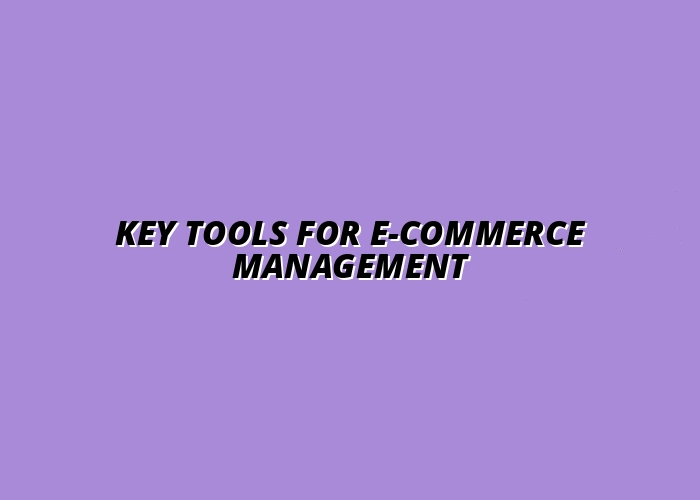Key Tools for E-Commerce Management

Posted on: 2025-10-03
By: Liam Corbin
In the fast-paced world of e-commerce, the right tools can make all the difference. Research indicates that businesses leveraging efficient operational tools can experience up to a 30% increase in productivity. This article delves into how selecting the appropriate tools can enhance your online business's success and sustainability.
What You Will Learn
- The significance of choosing tools that align with your specific business goals for optimal performance.
- Key characteristics to look for in e-commerce tools, including scalability, user-friendliness, and integration capabilities.
- An overview of popular e-commerce platforms like Shopify, WooCommerce, and BigCommerce, highlighting their unique advantages.
- How to enhance customer engagement and sales through effective marketing and analytics tools.
- The importance of reviewing current tools and gathering user feedback for continuous improvement and strategy adaptation.
Key Considerations for Selecting E-Commerce Tools
It's essential to evaluate key factors when choosing tools for your e-commerce business. For deeper insights into managing your online store effectively, consider exploring resources on building a successful e-commerce site.
Scalability
Can the tool grow with your business?
User-friendliness
Is the interface easy to navigate?
Integration
Does it work well with other tools you’re using?
Cost-effectiveness
Is it within your budget?
Understanding the Role of Essential Tools in E-Commerce Management
In the world of e-commerce, having the right tools at your disposal is like having a good roadmap. They guide you through the complexities of running an online business and can significantly impact your success. At The Cash Automator, I understand that managing an online store isn't just about selling products; it's about using the right strategies and tools to optimize your operations and grow your business.
Choosing the right tools can propel your business forward. They help you streamline processes, analyze customer behavior, and enhance marketing efforts. As I’ve learned through my journey, investing time in selecting these tools is crucial for achieving sustainable growth and long-term success.
Why Selecting the Right E-Commerce Tools Matters for Business Growth
When starting an online business, I realized that not all tools are created equal. The right e-commerce tools can help you achieve specific goals and improve overall efficiency. Think about it—if you’re using software that doesn’t fit your needs, you’re likely to encounter roadblocks that could slow down your progress.
Some benefits of selecting the right tools include:
- Increased efficiency: Automating repetitive tasks saves you time.
- Better customer insights: Analytics tools help you understand your audience.
- Streamlined operations: Effective inventory and order management tools simplify processes.
These advantages can lead to improved customer satisfaction and ultimately, higher sales, which is what every e-commerce entrepreneur aims for! To further boost your sales, consider implementing effective e-commerce email marketing tips.
Key Considerations When Choosing Tools for Your E-Commerce Store
As you dive into the world of e-commerce, it’s important to keep a few key considerations in mind while selecting your tools. First, think about the specific needs of your business. Are you focusing on inventory management, marketing, or customer engagement? Identifying your priorities will help narrow down your options.
Here are some important factors to consider when choosing your e-commerce tools:
- Scalability: Can the tool grow with your business?
- User-friendliness: Is the interface easy to navigate?
- Integration: Does it work well with other tools you’re using?
- Cost-effectiveness: Is it within your budget?
By carefully evaluating these aspects, you can make informed decisions that align with your business goals and set you on the path to success!
Popular E-Commerce Platforms: Shopify, WooCommerce, and BigCommerce
There are several e-commerce platforms available, each with its unique features. Personally, I've had great experiences with Shopify, WooCommerce, and BigCommerce. Let’s break them down:
- Shopify: Known for its user-friendly interface and extensive app ecosystem, making it perfect for beginners.
- WooCommerce: This is a WordPress plugin that allows for great customization, appealing to those who have some technical know-how.
- BigCommerce: Offers robust built-in features suited for larger businesses, focusing on scalability.
Choosing the right platform is crucial because it can influence everything from your site's layout to how you manage inventory. Taking the time to assess each option based on your business model will help you make a better choice. For those interested in automation, learning how to automate your e-commerce sales efficiently can provide a significant advantage.
Pro Tip
When selecting e-commerce tools, consider starting with a trial period or free version. Many platforms offer these options, allowing you to test their features and usability before making a financial commitment. This way, you can ensure that the tools align with your business needs and workflows, ultimately leading to more informed decisions.
Summarizing the Essential Tools for E-Commerce Management
When it comes to running a successful e-commerce business, having the right tools is crucial! From inventory management to customer engagement, choosing essential tools can make a big difference. At The Cash Automator, I've seen firsthand how effective tools can streamline operations and boost sales. So, let's highlight some key takeaways for selecting the right e-commerce tools for your business!
Firstly, always consider your business goals. Whether you're focused on improving customer experience or optimizing sales processes, the right tools should align with your objectives. Additionally, think about integrating tools that work well together, as this will save you time and reduce potential headaches. Lastly, don’t forget to evaluate the cost versus the benefits of each tool to ensure you’re making a sound investment for your e-commerce store.
- Align tools with your business goals.
- Ensure compatibility between different tools.
- Evaluate costs against potential benefits.
Key Takeaways for Selecting the Right E-Commerce Tools
Now that we've covered the basics, let’s dig deeper into some practical takeaways for your tool selection process. The right tools can enhance every aspect of your e-commerce business. For example, using the right marketing automation tools can drive customer engagement and improve sales conversion rates. By integrating analytics tools, you can gain valuable insights into customer behavior, enabling you to make informed decisions.
Don’t forget about the importance of user-friendly platforms! Tools that offer a straightforward experience can minimize the learning curve and help you stay focused on growing your business. Plus, prioritize tools with good customer support, as this can save you time when you need assistance. Remember, your ultimate goal is to create a seamless experience for both you and your customers!
- Enhance marketing efforts with automation tools.
- Use analytics for data-driven decisions.
- Opt for user-friendly platforms with solid customer support.
Frequently Asked Questions (FAQs)
- Q: Why is selecting the right e-commerce tools important?
- A: Selecting the right tools is crucial because they streamline operations, enhance customer insights, improve marketing efforts, and ultimately lead to increased efficiency and higher sales. They help businesses achieve specific goals and ensure long-term sustainability.
- Q: What key factors should I consider when choosing e-commerce tools?
- A: Key factors include scalability (can it grow with your business?), user-friendliness (is it easy to navigate?), integration (does it work with other tools?), and cost-effectiveness (is it within your budget?).
- Q: What are some popular e-commerce platforms?
- A: Popular platforms include Shopify (user-friendly, extensive app ecosystem), WooCommerce (WordPress plugin, high customization), and BigCommerce (robust features for larger businesses, scalability-focused).
- Q: How can I ensure my tools align with my business goals?
- A: Start by identifying your specific business needs (e.g., inventory, marketing, customer engagement). Then, evaluate tools based on how well they address these needs and contribute to your objectives, ensuring compatibility and evaluating costs versus benefits.
- Q: How important is user feedback in tool selection and improvement?
- A: User feedback is essential for continuous improvement. It provides valuable insights into how your tools and website are performing from a customer perspective, allowing you to make informed adjustments that enhance satisfaction and strengthen brand loyalty.
Encouraging Action: Tailoring Your Tool Selection to Business Needs
As you embark on your e-commerce journey, it’s vital to assess your current tools and identify gaps in your strategy. You might be surprised at what you find! By reviewing the tools you’re already using, you can pinpoint areas where improvement is needed or where new tools could be integrated. At The Cash Automator, I always encourage users to be proactive in adapting their strategies for better outcomes. You can also learn more about sustainable growth for e-commerce business to further your understanding.
Additionally, engaging with user feedback is essential for continuous improvement. Listen to what your customers have to say about their experiences with your website and tools. This feedback can offer valuable insights that help you refine your approach and make necessary adjustments for maximum effectiveness.
- Review current tools and identify gaps.
- Engage with user feedback for improvements.
- Adapt strategies for ongoing success.
Engaging with User Feedback and Continuous Improvement
To truly excel in e-commerce, you need to foster a culture of continuous improvement. Engage with your customers regularly, whether through surveys or direct communication. Their insights can guide you in making informed changes to your offerings and tools. This not only enhances customer satisfaction but also strengthens your brand loyalty.
Remember, the e-commerce landscape is constantly evolving, so staying agile is key! Regularly evaluate your tools and strategies, making adjustments as needed. As you grow and learn, you’ll find that the right tools will not only streamline your processes but also empower you to build a thriving online business. For additional insights on managing your online operations, consider exploring tips to streamline your online business today.
So, are you ready to take action? Start assessing your e-commerce tools today and watch your business flourish!
Recap of Key Points
Here is a quick recap of the important points discussed in the article:
- Selecting the right e-commerce tools is critical for enhancing efficiency, gaining customer insights, and streamlining operations.
- Consider key factors such as scalability, user-friendliness, integration, and cost-effectiveness when choosing tools.
- Popular platforms like Shopify, WooCommerce, and BigCommerce each have unique features catering to different business needs.
- Align your tools with your business goals and ensure they are compatible with each other to optimize your operations.
- Continuous engagement with user feedback is essential for refining your tools and strategies for better outcomes.
- Regularly review your e-commerce tools to adapt and improve your business as the market evolves.
 Creating a membership site can be your gateway to generating income effortlessly, allowing you to ea
Creating a membership site can be your gateway to generating income effortlessly, allowing you to ea
 As the e-commerce landscape evolves, small businesses must adapt to stay competitive. Did you know t
As the e-commerce landscape evolves, small businesses must adapt to stay competitive. Did you know t
 When it comes to affiliate marketing, leveraging the power of webinars can transform your approach.
When it comes to affiliate marketing, leveraging the power of webinars can transform your approach.